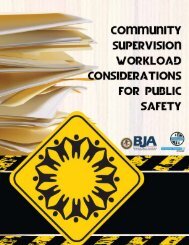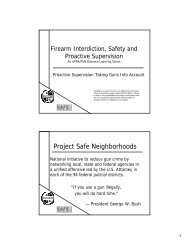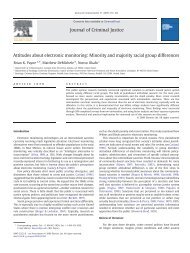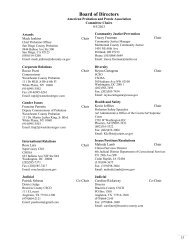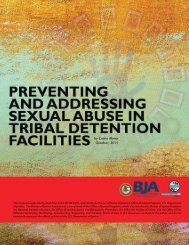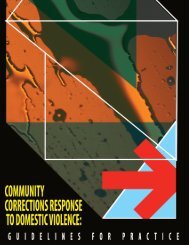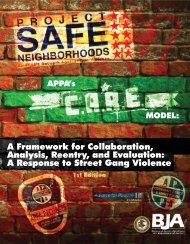Intervention Principles and Practice Guidelines for - Underage ...
Intervention Principles and Practice Guidelines for - Underage ...
Intervention Principles and Practice Guidelines for - Underage ...
You also want an ePaper? Increase the reach of your titles
YUMPU automatically turns print PDFs into web optimized ePapers that Google loves.
The basic reality is that family members often have responsibilities toward each other, <strong>and</strong> most<br />
families continue to demonstrate their loyalty even during tough times. Individuals involved in<br />
the juvenile or criminal justice system often appear in court with someone. People attending drug<br />
treatment can almost always name a loved one who is willing to provide support. Finding ways to<br />
activate <strong>and</strong> leverage that mutual loyalty <strong>and</strong> support, <strong>and</strong> reminding individuals involved in the justice<br />
system that their actions affect other members of their network, can motivate <strong>and</strong> facilitate change<br />
(Mullins & Toner, 2008).<br />
The Family Support Approach <strong>for</strong> Community Supervision, as developed by Family Justice <strong>and</strong> in<br />
partnership with the American Probation <strong>and</strong> Parole Association, provides a framework <strong>and</strong> tools (see<br />
Exhibit V-o) that community corrections professionals can use to engage families <strong>and</strong> social networks<br />
by helping a youth or young adult identify <strong>and</strong> leverage the support of their families <strong>and</strong> social<br />
networks to help them meet their community supervision (or diversion) goals <strong>and</strong> objectives (Mullins<br />
& Toner, 2008). In the context of the Family Support Approach, family is broadly defined. It includes,<br />
but is not limited to, blood relations. It also encompasses the network of people who are significant<br />
in an individual’s life (e.g., positive peers, roommates, teachers, coaches, neighbors, work associates,<br />
counselors, religious leaders, 12-step sponsors, workers at a youth service organization).<br />
One way the families <strong>and</strong> social networks can be called upon to help is by monitoring <strong>and</strong><br />
supervising the behavior of youth. The amount of time that community supervision professionals<br />
spend with youth or young people under supervision is fairly limited, when compared to the amount<br />
of time that these young people spend with their families <strong>and</strong> social networks of support. There<strong>for</strong>e,<br />
these individuals are in a unique position to provide support that a government entity cannot. They<br />
can also take note of warning signs that the youth may be engaging in activities contrary to his or her<br />
supervision conditions or program requirements that could ultimately lead to a violation or revocation<br />
if not addressed promptly.<br />
For example, parents or legal guardians or other supportive adults of youth under the age of 18 can<br />
<strong>and</strong> should participate in monitoring <strong>and</strong> supervising the behavior of youth including such practices as<br />
(Bonnie & O’Connell, 2004):<br />
• Knowing the youth’s friends.<br />
• Making sure youth are always supervised by adults.<br />
• Knowing a youth’s plans <strong>for</strong> the day or evening.<br />
• Knowing what youth are doing when away from home.<br />
• En<strong>for</strong>cing evening curfews.<br />
• Being involved together with youth in projects <strong>and</strong> activities.<br />
• Using appropriate punishments <strong>for</strong> inappropriate behavior <strong>and</strong> rewards <strong>for</strong> positive behaviors.<br />
76



